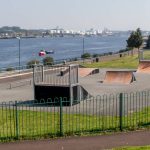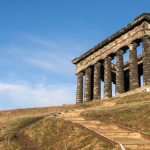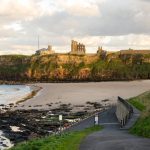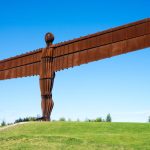Situated slightly closer to the rising sun than Newcastle upon Tyne, Hebburn is the kind of suburban town we long to raise our kids in. Naturally, we couldn’t wait to delve in and find out what it is like as a holiday destination. The bets are in, the lead runner is ‘wholesome’, let’s see what else the locals have to say about living in Hebburn – including the best bits.
The Early History of Hebburn, Tyne & Wear
Once a peaceful fishing village, the modern town of Hebburn kept its leafy tranquillity down through the centuries. Historically it was part of County Durham, which was so far north that it even gave the Romans chills. The hamlet grew up in the post-Roman era, under the quiet rule of the Saxon kings.
The town takes its name from Anglo-Saxon times, where historians suspect it meant ‘high tumulus’. A tumulus is a weirdly shaped little hill, to spare you the Google. You know those hills that look like little bumps in the field? Nobody is really sure where the tumulus was, only that the town is named after it. Other thoughts on the name suggest it may be a name for a burial place or a town beside the water.
Hebburn was originally enclosed in land owned by the Norman Monastery nearby. After the dissolution of the monasteries, it fell into the hands of both the Willys and the Baxter families. Towns were like pets back then. They were owned by people.
In the 8th century, the hamlet was a collection of fishing huts. The apparent poverty of the inhabitants did nothing to stop the Vikings from raiding and burning it. Hebburn regrew, and the fishing was too good to give up.
The Medieval Period in the Newcastle Suburbs
Hebburn Hall is the local large stately home. It opened in the 17th century, but it replaced a far older building. Newcastle University records that there was a fortified manor on the grounds which dated as early as the 14th century. Certainly, during the 14th century, the town was under the watchful eye of the residents/guards at Peel Tower. This is one of many strategic historic towers placed along the border with Scotland. Nobles needed a place to regroup when they got into fights over cattle.
Hebburn is not even in the Domesday Survey. We can usually rely on that document for a bit of medieval information, but this far north the officials of King William just said no. They went home. The north was cold, unruly, and everyone tried to kill them in it.
By the 1400s the wealthy Ellison family bought the manor house, which had passed through multiple hands by then. It was this family who opened the first deep-pit coal mines in town. They used the coal money to revamp the house as we know it today, over the fortified mansion that it was before. Evidently, the previous owners were still scared of Vikings.
Five Fun Things to Bring Out at Parties
Want to know what the best gossip is from the history of the town? This section allows us to indulge our high-school-student side with the juiciest facts about Hebburn. Here are the current top playground rumours about the town on the Tyne:
- One of the most famous ships built in the Hebburn ports was the HMS Kelly, in 1938. The ship was commanded by Lord Mountbatten but was sunk in the evacuation of Crete during the war. Bombed by the Luftwaffe, HMS Kelly lost fully half her crew to the sea.
- Pre-war, Hebburn was still just a small town on the river. After the war, the town exploded to a population of 20,000 people.
- The Hebburn Colliery was intrinsic to the development of the Davy Lamp, the eventual saviour of thousands of miners. Sir Humphry Davy took samples of the explosive methane gas found in the Hebburn colliery while he was staying at Hebburn Hall with friends in 1815. He kept the glass in wine bottles until they could evaluate them. The Davy Lamp was later assessed in Hebburn Colliery owing to the huge gas pockets. The results were remarkable. The Davy Lamp soaked up the fire damp, making the lights brighter in worse conditions.
- In 1857, Hebburn was still a small town. However, now it had everything that a miner and his family needed to survive. It had a post office, a school, a pub, a brickmaker, two shipyards and a chapel.
- Hebburn and Hebburn Quay were two different villages for years until expansion made them connect. If you look closely enough, you can still detect the remnants of distrust on either side.
And after stirring that particular long-forgotten pot, let’s get back to something we are less good at history.
The Industrial Era on the River Tyne
One of the big issues we have come across in all the tour guides we have covered in this section of the country lies in natural gas. Underneath the outskirts of Newcastle, there ran (or potentially still runs) a vast coal seam. Discovered fairly early in the 18th century, this area in the north was mining coal from deep pits as soon as the technology became available. Unfortunately for many of the miners, the tech to deep mine advanced before the tech that would keep them safe at those depths.
As a result, this whole stretch of land east of Newcastle saw countless miners’ deaths due to explosions underground. The miners worked by candlelight, forever chipping away at the rock, every chip possibly the one that would explode. What a terrifying way to live.
John Buddle
In 1852 mining operations in Hebburn had been underway for around 100 years already. Still, technology was not evolved enough to keep people safe underground. John Buddle, a locally-born mining engineer, devised lamps to help add safety to the process in the early 1800s, but it was still dangerous.
The local registrar recorded that 22 souls lost their lives at Hebburn in 1852. An explosion in the Easton and Co. mine shaft saw 22 of the men and boys working in the Monkton Flat suffocate to their deaths. One of the wives of the miners, they record, lost her first husband in a similar accident.
Coal mining continued until 1932 in Hebburn, having begun in the mid-1700s. After coal mining gave way to new industries, the shipyards opened. Companies such as Hawthorn Leslie and Palmers gave timely work to the thousands of laid-off miners. In 1872 a shipyard owner paid for the local Church of St Andrews. We are sure he would be delighted to find that nowadays, this building is a Buddhist meditation centre – Omm.
The Train Arrives
The railway opened here in 1872 after a boom in industry during the Victorian era. Much of the main street in Hebburn dates to this time. A Frenchman owned an electrical switch business here from 1901 and Andrew Leslie was the biggest shipbuilder in town as a Scotsman arriving in 1850. He launched 255 ships from Hebburn before 1885.
Towards the end of the 19th century, the miners and shipbuilders needed more space to house their families. The Hebburn New Town grew up just north of the Quay, which foreshadowed the inevitable joining of the two settlements.
On an important side note, Leslie was a major figure in the history of the town. He didn’t just build a church, he brought in countless workers from Aberdeen to man the mines. The local population wasn’t large enough to cater to the demand for coal. Hebburn earned the nickname of ‘Little Aberdeen’ among the locals. This was interesting since Leslie himself was all the way from Shetland. They also brought in miners from Ireland, another popular tactic all over this area. There are reasons why the north sticks together nowadays… the north remembers!
Modern Life in Hebburn
Leslie later opened a shipyard, which was still in operation in 1982. In 1888, the town received the Catholic Church of St. Aloysius, which is the red brick building still in use today. Up until 1990, coal coking took place just outside of town. Monkton Village, asides from once housing a monastery, was a dumping ground for industrial waste.
The area is now covered in parkland and rewilding is well underway. The Monkton coke works closed in 1990, which was followed by a period of clearing the bings, the large slag heaps. Now, the land is green and a small forest is arising. Monkton was also the birthplace of St. Bede until it was later proclaimed to be in Sunderland. The spring water from this town was once thought to heal sick children.
War Time Hebburn
During the World Wars, Hebburn was too valuable an industrial site to house evacuee children. Instead, some of the plants and warehouses in town turned to the process of munitions making. Although not an essential site, the Germans bombed it anyway. One horrible night in 1941 saw 12 ARPs and three children lose their lives. Since local tabloids were censured from saying too much, the incident was neatly and simply and completely un-justifiably recorded as ‘considerable damage to a local town.’ Let’s not forget the contribution the shipyards made to the war effort.
Hebburn Colliery finally closed its doors in 1932. 200 miners died during the course of its opening. Those 200 bodies didn’t all make it out of the hole. The youngest victim recorded was ten, although this is likely misrepresented. Some miners’ kids had to work younger than that.
A 2012 BBC comedy series named after the town aired to the masses. In 2011, the Reyrolle & Company short circuit testing plant near Monkton closed its doors.
All over the modern, pleasant, green town of Hebburn, there are hints of its industrial past. While it harbours workers from the city who commute each day, Hebburn still sees the odd day-tripper down the river. It is the kind of place people from the city move to so that they can raise their children. It is still an important industrial town, but now the working conditions are far better and the industry revolves around wind turbines.
Famous People from Hebburn, Tyne & Wear
In this section of our travel guides, we like to cover the famous people who have come from the area, in this case, Hebburn. This far north we expect a barrage of footballers, a few singers, an actor or five, and some really special people. You know the ones… the opera singers, the humanitarians, the people who were found living with wolves in the forest? Here are the coolest celebs out of Hebburn:
- Jason Cook, who wrote Hebburn the TV show
- Frank Wappat, a BBC Radio presenter
- Songwriter John Miles is a Hebburn man
- Composer Robert Saint, who wrote ‘the Miner’s Hymn’
- Andrew Leslie couldn’t make it on this list fast enough
- Several footballers, including George Armstrong, Chris Basham, Ian Chipchase, John Dixon, Jack English, and a dozen or two more.
Hebburn has had its fair share of famous people over the years. Let’s move on to the attractions that brought them to the area.
Best Attractions in Hebburn
Hebburn has some wonderful attractions that you ought to experience while you are in town. Here are the favourite attractions locals love in and around the town on the River Tyne.
Historic Sites
Hebburn Hall has undergone several transformations since it was a fortified manor in the 14th century. Most recently it transformed into residential apartments. You can still go out there and see it and it is still a Grade II listed building. It was a Freemasons Masonic Lodge until 1999. Before that, it belonged to the Ellison family. St John’s Church opened as an addition in the 1880s, built into the former servant’s wing. The east wing was also a temporary infirmary at one point. There is a lot of history at Hebburn Hall, and maybe even one or two ghosts.
Landmarks
Those of you who have an adventurous side might enjoy a walk around the woodland on Adair Way. This is where they found St Bede’s healing well. Take a walk through the small woodland to find it or take your chances bathing in the spring. We are not sure we would, with all that methane gas down there.
Hebburn Riverside Park is another favourite among locals. This landmark country park features nature walks for the kids and picnic areas for families. You get a splendid view of the port and the ships passing from here. The park opened in the 1970s and covers about 75 acres of land. This is an area of rewilding, bringing new life to the old copper processing and sulphur works that used to use the river. Go a the right time of the year and it is full of Mute Swan Cygnets and ducklings!
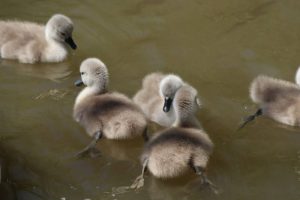
Cygnets abound at Hebburn Riverside Park in late spring
Image: Gartland/Shutterstock.com
Cultural Sites
You can pay your respects to the war memorial in Carr-Ellison park. The monument commemorates the hundreds of soldiers who died in both great wars.
The nearest museum and art gallery is in South Shields. There is also the Segedunum Roman Fort Museum and the Jarrow hall in the neighbouring town.
Outdoor Attractions
One of the best outdoor areas in town is Hebburn Fountain park. This is where the locals come to sunbathe, dog walk, spend time playing with a ball, and generally bond. There are fountains, but they are not always on. In the typical UK style, money is more important than that pleasantry. The park is within walking distance of the shopping district and features a lovely lawn with walking space to stretch your legs in.
If you really want to stretch your legs, or if you are a cyclist looking for a route, Monkton Fell is the route around the local hill. This route takes you through sections of forest, along the edges of fields, and even around housing estates. It’s a good hike if you have the mobility for it.
Sports and Recreation
There are two local golf clubs to choose from. Head to the Heworth Golf Club in Gateshead or choose the Boldon Golf Club, near Bolden Colliery. Boldon is a beautiful course between rolling hills.
Hebburn has its own football club. New to the area? Go join them or visit for a match. Hebburn Town FC plays at the Hebburn Social Ground. There isn’t a RUFC in town, the Jarrovians are the nearest rugby club.
Hebburn has its own skate park where local kids come to show off and hone their skills. The park is an all-concrete skate park with a mini ramp and a flat bank. The park has a quarter pipe and nice, smooth concrete to work with. It is literally where the cool kids hang out.
Things to do in Hebburn with Kids?
There are some attractions that are just for them. Your nearest kids’ amusement centre is in Gateshead, at Mister Twister’s Jump Centre. As you can imagine, this is a trampoline-based adventure playground. Hebburn town council run a soft play in the Hebburn Central building. This community centre also has a library, fitness classes, a local gym, and meeting rooms for hire.
If you want your little tyke to take part in classes and fun creative workshops, get them along to Role Play. There is a miniature village and coffee and snacks for the grownups. This is aimed at babies and younger children. It helps develop sensory perception. The project has been so successful that the brand recently opened a second location.
Where to eat and drink?
If you want a light snack throughout the day, Café L is inside St James’ Mall near the town centre. If you love Italian food, try Le Olive Verdi for an impressive pizza. You can eat and drink the night away at The Longship, which is technically a hotel and therefore a wonderful place to stay in Hebburn, too. There is also the Ben Lomond bar if you want to get a few cocktails while you nibble. Remember, there is a huge Scottish ancestry in this area. For the best cocktails nearby take yourself to the Botanist in Newcastle. They also serve great food.
Where to shop in Hebburn?
Mountbatten shopping centre in Hebburn town centre is the main place for you shopaholics. It is partially covered so you can enjoy your favourite pastime even when it is raining. You will find it near St. James’ Mall, which is similar. Between both places, you will find everything you need.
Other Notable Nearby Attractions
Hebburn sits perfectly between a bunch of other great sites, towns, and beaches. If you want to enjoy the other notable attractions this area has to offer, try and squeeze in these stops on your tour:
- Head a bit more east till you get to Tynemouth. Spend a day at the Spanish Garrison.
- Visit Wallsend – also known by the Romans as Segedunum – and see the old Roman fort and Hadrian’s Wall.
- Visit nearby Washington, which is beside the Angel of the North.
- Spend a day at the seaside in Whitley Bay.
- Shop till you drop in Newcastle City Centre.
- Can’t get enough seaside? Try North or South Shields for kicks.
Between these locations, you are bound to find sensational staycation fun this year.
How to get to Hebburn
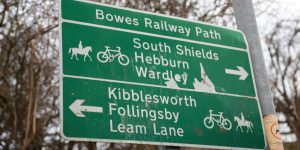
Image: Graeme J Baty/Shutterstock.com
You are almost caught up with all there is to know about this sweet riverside town. We will leave you with these directions, should you choose to accept them. They probably won’t’ self-destruct. Probably.
By Road
Follow that coastal road straight east out of Newcastle. If in doubt put NE31 into your sat nav.
By Rail
Hebburn is so close to Newcastle that it is on the Metro line. So Head for the main station and go from there.
By Air
Your nearest airport is Newcastle.
By Sea
Look for the port at Hebburn.
Spare us a Favour?
If you have a spare five minutes, we would love your help with something. Heading to Facebook and clicking the like button would be tremendous of you. Otherwise, a simple like and share of your home town’s travel guide would be fantastic.

